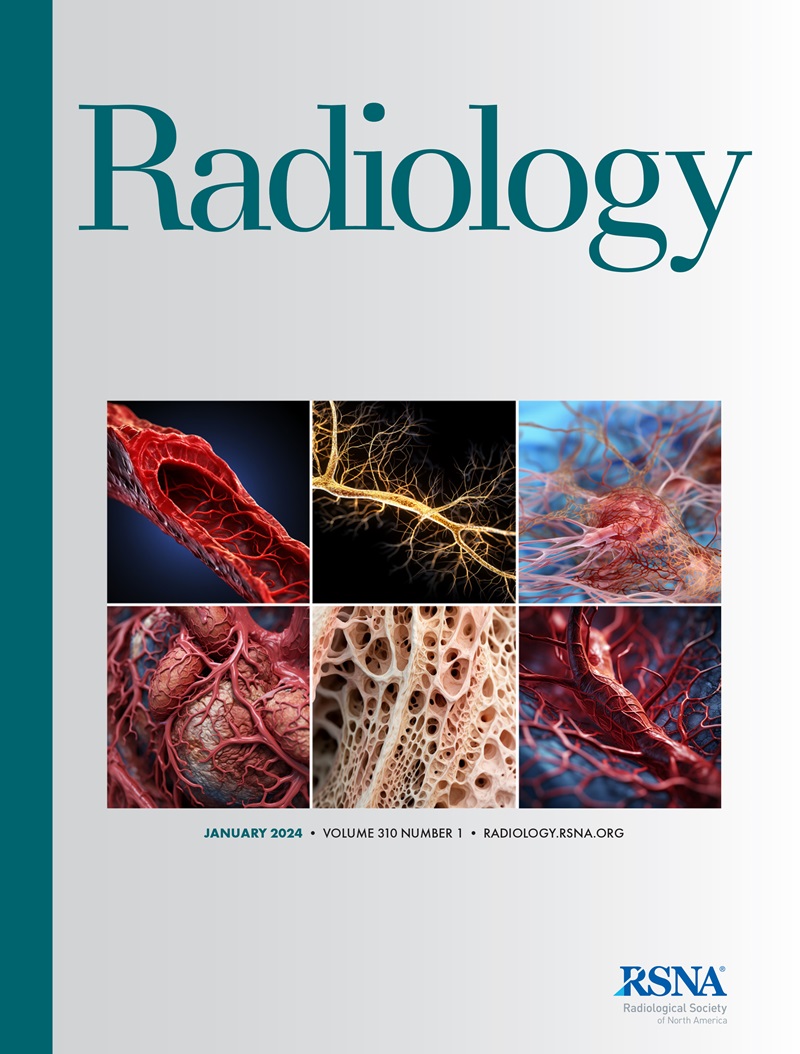下载PDF
{"title":"3 T 磁场强度下阿尔茨海默病的氘代谢成像:一项试点病例对照研究","authors":"Alixander S Khan, Katie A Peterson, Orsolya I Vittay, Mary A McLean, Joshua D Kaggie, John T O'Brien, James B Rowe, Ferdia A Gallagher, Tomasz Matys","doi":"10.1148/radiol.232407","DOIUrl":null,"url":null,"abstract":"<p><p>Background Impaired glucose metabolism is characteristic of several types of dementia, preceding cognitive symptoms and structural brain changes. Reduced glucose uptake in specific brain regions, detected using fluorine 18 (<sup>18</sup>F) fluorodeoxyglucose (FDG) PET, is a valuable diagnostic marker in Alzheimer disease (AD). However, the use of <sup>18</sup>F-FDG PET in clinical practice may be limited by equipment availability and high cost. Purpose To test the feasibility of using MRI-based deuterium (<sup>2</sup>H) metabolic imaging (DMI) at a clinical magnetic field strength (3 T) to detect and localize changes in the concentration of glucose and its metabolites in the brains of patients with a clinical diagnosis of AD. Materials and Methods Participants were recruited for this prospective case-control pilot study between March 2021 and February 2023. DMI was performed at 3 T using a custom birdcage head coil following oral administration of deuterium-labeled glucose (0.75 g/kg). Unlocalized whole-brain MR spectroscopy (MRS) and three-dimensional MR spectroscopic imaging (MRSI) (voxel size, 3.2 cm cubic) were performed. Ratios of <sup>2</sup>H-glucose, <sup>2</sup>H-glutamate and <sup>2</sup>H-glutamine (<sup>2</sup>H-Glx), and <sup>2</sup>H-lactate spectroscopic peak signals to <sup>2</sup>H-water peak signal were calculated for the whole-brain MR spectra and for individual MRSI voxels. Results A total of 19 participants, including 10 participants with AD (mean age, 68 years ± 5 [SD]; eight males) and nine cognitively healthy control participants (mean age, 70 years ± 6; six males) were evaluated. Whole-brain spectra demonstrated a reduced ratio of <sup>2</sup>H-Glx to <sup>2</sup>H-glucose peak signals in participants with AD compared with control participants (0.41 ± 0.09 vs 0.58 ± 0.20, respectively; <i>P</i> = .04), suggesting an impairment of oxidative glucose metabolism in AD. However, there was no evidence of localization of these changes to the expected regions of metabolic impairment at MRSI, presumably due to insufficient spatial resolution. Conclusion DMI at 3 T demonstrated impairment of oxidative glucose metabolism in the brains of patients with AD but no evidence of regional signal differences. © RSNA, 2024 <i>Supplemental material is available for this article.</i></p>","PeriodicalId":20896,"journal":{"name":"Radiology","volume":null,"pages":null},"PeriodicalIF":12.1000,"publicationDate":"2024-07-01","publicationTypes":"Journal Article","fieldsOfStudy":null,"isOpenAccess":false,"openAccessPdf":"https://www.ncbi.nlm.nih.gov/pmc/articles/PMC11294762/pdf/","citationCount":"0","resultStr":"{\"title\":\"Deuterium Metabolic Imaging of Alzheimer Disease at 3-T Magnetic Field Strength: A Pilot Case-Control Study.\",\"authors\":\"Alixander S Khan, Katie A Peterson, Orsolya I Vittay, Mary A McLean, Joshua D Kaggie, John T O'Brien, James B Rowe, Ferdia A Gallagher, Tomasz Matys\",\"doi\":\"10.1148/radiol.232407\",\"DOIUrl\":null,\"url\":null,\"abstract\":\"<p><p>Background Impaired glucose metabolism is characteristic of several types of dementia, preceding cognitive symptoms and structural brain changes. Reduced glucose uptake in specific brain regions, detected using fluorine 18 (<sup>18</sup>F) fluorodeoxyglucose (FDG) PET, is a valuable diagnostic marker in Alzheimer disease (AD). However, the use of <sup>18</sup>F-FDG PET in clinical practice may be limited by equipment availability and high cost. Purpose To test the feasibility of using MRI-based deuterium (<sup>2</sup>H) metabolic imaging (DMI) at a clinical magnetic field strength (3 T) to detect and localize changes in the concentration of glucose and its metabolites in the brains of patients with a clinical diagnosis of AD. Materials and Methods Participants were recruited for this prospective case-control pilot study between March 2021 and February 2023. DMI was performed at 3 T using a custom birdcage head coil following oral administration of deuterium-labeled glucose (0.75 g/kg). Unlocalized whole-brain MR spectroscopy (MRS) and three-dimensional MR spectroscopic imaging (MRSI) (voxel size, 3.2 cm cubic) were performed. Ratios of <sup>2</sup>H-glucose, <sup>2</sup>H-glutamate and <sup>2</sup>H-glutamine (<sup>2</sup>H-Glx), and <sup>2</sup>H-lactate spectroscopic peak signals to <sup>2</sup>H-water peak signal were calculated for the whole-brain MR spectra and for individual MRSI voxels. Results A total of 19 participants, including 10 participants with AD (mean age, 68 years ± 5 [SD]; eight males) and nine cognitively healthy control participants (mean age, 70 years ± 6; six males) were evaluated. Whole-brain spectra demonstrated a reduced ratio of <sup>2</sup>H-Glx to <sup>2</sup>H-glucose peak signals in participants with AD compared with control participants (0.41 ± 0.09 vs 0.58 ± 0.20, respectively; <i>P</i> = .04), suggesting an impairment of oxidative glucose metabolism in AD. However, there was no evidence of localization of these changes to the expected regions of metabolic impairment at MRSI, presumably due to insufficient spatial resolution. Conclusion DMI at 3 T demonstrated impairment of oxidative glucose metabolism in the brains of patients with AD but no evidence of regional signal differences. © RSNA, 2024 <i>Supplemental material is available for this article.</i></p>\",\"PeriodicalId\":20896,\"journal\":{\"name\":\"Radiology\",\"volume\":null,\"pages\":null},\"PeriodicalIF\":12.1000,\"publicationDate\":\"2024-07-01\",\"publicationTypes\":\"Journal Article\",\"fieldsOfStudy\":null,\"isOpenAccess\":false,\"openAccessPdf\":\"https://www.ncbi.nlm.nih.gov/pmc/articles/PMC11294762/pdf/\",\"citationCount\":\"0\",\"resultStr\":null,\"platform\":\"Semanticscholar\",\"paperid\":null,\"PeriodicalName\":\"Radiology\",\"FirstCategoryId\":\"3\",\"ListUrlMain\":\"https://doi.org/10.1148/radiol.232407\",\"RegionNum\":1,\"RegionCategory\":\"医学\",\"ArticlePicture\":[],\"TitleCN\":null,\"AbstractTextCN\":null,\"PMCID\":null,\"EPubDate\":\"\",\"PubModel\":\"\",\"JCR\":\"Q1\",\"JCRName\":\"RADIOLOGY, NUCLEAR MEDICINE & MEDICAL IMAGING\",\"Score\":null,\"Total\":0}","platform":"Semanticscholar","paperid":null,"PeriodicalName":"Radiology","FirstCategoryId":"3","ListUrlMain":"https://doi.org/10.1148/radiol.232407","RegionNum":1,"RegionCategory":"医学","ArticlePicture":[],"TitleCN":null,"AbstractTextCN":null,"PMCID":null,"EPubDate":"","PubModel":"","JCR":"Q1","JCRName":"RADIOLOGY, NUCLEAR MEDICINE & MEDICAL IMAGING","Score":null,"Total":0}
引用次数: 0
引用
批量引用


